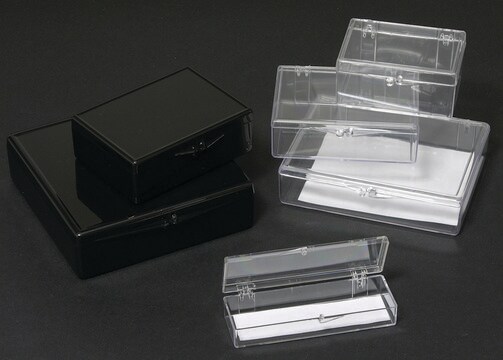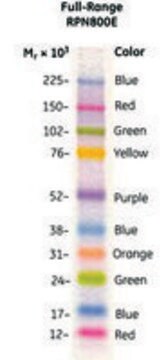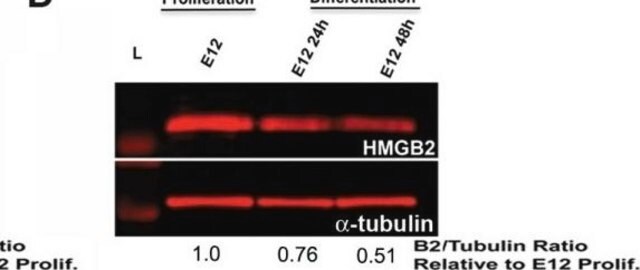ABS2103
Anti-BiP (GRP78) Antibody, arginylated (Nt-Glu19)
from rabbit, purified by affinity chromatography
Synonyme(s) :
78 kDa glucose-regulated protein, Nt-Glu19 arginylated, BiP, Nt-Glu19 arginylated, Endoplasmic reticulum lumenal Ca(2+)-binding protein grp78, Nt-Glu19 arginylated, GRP-78, Nt-Glu19 arginylated, Heat shock 70 kDa protein 5, Nt-Glu19 arginylated, Immunogl
About This Item
Produits recommandés
Source biologique
rabbit
Niveau de qualité
Forme d'anticorps
affinity isolated antibody
Type de produit anticorps
primary antibodies
Clone
polyclonal
Produit purifié par
affinity chromatography
Espèces réactives
human, mouse
Réactivité de l'espèce (prédite par homologie)
rat (based on 100% sequence homology), bovine (based on 100% sequence homology), nonhuman primates (based on 100% sequence homology)
Technique(s)
ELISA: suitable
dot blot: suitable
immunocytochemistry: suitable
western blot: suitable
Numéro d'accès NCBI
Numéro d'accès UniProt
Conditions d'expédition
ambient
Modification post-traductionnelle de la cible
unmodified
Informations sur le gène
human ... HSPA5(3309)
Description générale
Spécificité
Immunogène
Application
Signaling
Immunocytochemistry Analysis: 10 µg/mL from a representative lot detected BiP Nt-Glu19 arginylation induction in (18-hr 3 µM MG132 and 200 nM thapsigargin) treated HeLa cells (Courtesy of Yong Tae Kwon, Ph.D. , Seoul National University, Korea).
Immunocytochemistry Analysis: 10 µg/mL from a representative lot detected BiP Nt-Glu19 arginylation induction in (18-hr 3 µM MG132 and 200 nM thapsigargin) treated wild-type, but not arginine-tRNA-protein transferase 1/ATE1-deficient, MEFs (Courtesy of Yong Tae Kwon, Ph.D. , Seoul National University, Korea).
Western Blotting Analysis: 0.2 µg/mL from a representative lot detected BiP Nt-Glu19 arginylation induction in (18-hr 3 µM MG132 and 200 nM thapsigargin) treated HeLa cells (Courtesy of Yong Tae Kwon, Ph.D. , Seoul National University, Korea).
Western Blotting Analysis: 0.2 µg/mL from a representative lot detected a target R-BiP(19-651)-GFP fusion band in MEF cells transfected to express Ub-R-BiP(19-651)-GFP or Ub-BiP(19-651)-GFP, but not Ub-V-BiP(19-651)-GFP. In ATE1-deficient MEFs, the target R-BiP(19-651)-GFP band was detected only when the cells were tranfected to express Ub-R-BiP(19-651)-GFP, but not Ub-BiP(19-651)-GFP (Courtesy of Yong Tae Kwon, Ph.D. , Seoul National University, Korea).
Dot Blot Analysis: A representative lot detected the immunogen peptide, but not the control peptide without arginylation at the N-terminal Glu19 (Cha-Molstad, H., et al. (2015). Nat. Cell Biol. 17(7):917-929).
ELISA Analysis: A representative lot detected the immunogen peptide, but not the control peptide without arginylation at the N-terminal Glu19 (Cha-Molstad, H., et al. (2015). Nat. Cell Biol. 17(7):917-929).
Immunocytochemistry Analysis: A representative lot detected poly(dA:dT) transfection-induced formation of BiP arginylation/R-BiP-positive puncta co-localized with those containing p62, LC3, and ubiquitin conjugates, while R-BiP and ER stainings are mutually exclusive (Cha-Molstad, H., et al. (2015). Nat. Cell Biol. 17(7):917-929).
Western Blotting Analysis: A representative lot detected the production of R-BiP(19-651)-Tag fusions from exogenously expressed Ub-BiP(19-N)-Tag and Ub-R-BiP(19-N)-Tag, but not Ub-V-BiP(20-N)-Tag, constructs. In ATE1-deficient cells, the target R-BiP(19-651)-GFP band was detected only when the cells were tranfected to express Ub-R-BiP(19-651)-GFP, but not Ub-BiP(19-651)-GF (Cha-Molstad, H., et al. (2015). Nat. Cell Biol. 17(7):917-929).
Western Blotting Analysis: A representative lot detected BiP (GRP78) Nt-Glu19 arginylation induction upon arginine-tRNA-protein transferase 1 (ATE1) 1A7A isoform overexpression or transfection of various dsDNAs, including poly(dA:dT), in HeLa cells. Combined proteasome inhibition and ER stress induction by an 18-hr 10 µM MG132 and 100 nM thapsigargin treatment synergized the two drugs′ efficacy toward cellular Calreticulin Nt-Glu18 arginylation induction (Cha-Molstad, H., et al. (2015). Nat. Cell Biol. 17(7):917-929).
Qualité
Western Blotting Analysis: 1 µg/mL of this antibody detected BiP (GRP78) Nt-Glu19 arginylation induction in 7.5 µg of lysate from (17-hr 3 µM MG132 and 200 nM thapsigargin) treated HEK293 cells.
Description de la cible
Forme physique
Stockage et stabilité
Autres remarques
Clause de non-responsabilité
Vous ne trouvez pas le bon produit ?
Essayez notre Outil de sélection de produits.
Code de la classe de stockage
12 - Non Combustible Liquids
Classe de danger pour l'eau (WGK)
WGK 2
Point d'éclair (°F)
Not applicable
Point d'éclair (°C)
Not applicable
Certificats d'analyse (COA)
Recherchez un Certificats d'analyse (COA) en saisissant le numéro de lot du produit. Les numéros de lot figurent sur l'étiquette du produit après les mots "Lot" ou "Batch".
Déjà en possession de ce produit ?
Retrouvez la documentation relative aux produits que vous avez récemment achetés dans la Bibliothèque de documents.
Notre équipe de scientifiques dispose d'une expérience dans tous les secteurs de la recherche, notamment en sciences de la vie, science des matériaux, synthèse chimique, chromatographie, analyse et dans de nombreux autres domaines..
Contacter notre Service technique






